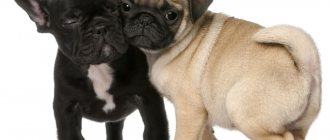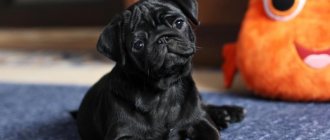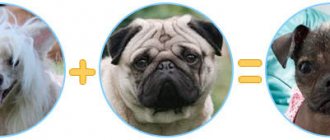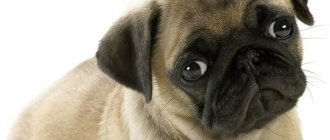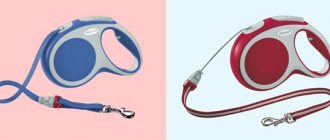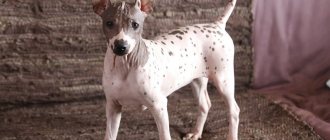Pug dogs look incredibly touching, they evoke kind smiles and a desire to pet and play. These cute guys are loyal, cheerful friends and have a lively, curious character. As a result, there are many who want to acquire such four-legged friends.
A well-chosen pug puppy is sure to become a favorite among all household members, without exception. Communication with this charming dog will give its owners many pleasant moments. Well, when a tiny pet grows up, it will not lose any of its charm and charm. An adult pug is guaranteed to turn into a full-fledged member of the family and will delight adults and children with devotion, cheerfulness, and kindness.
Recommendations for choosing a pug puppy
It is extremely important to take a responsible approach to choosing and purchasing a pug puppy. It is better to buy a puppy from a nursery, for example, Prederipag. It is extremely difficult to make a final decision in favor of a certain baby while in the nursery or at the breeder’s home. All the pug puppies running out to meet the potential buyer look incredibly touching. However, the choice will have to be made in favor of a certain dog, which will turn out to be the most desirable and the only one.
Show star or pet?
In any litter there are puppies belonging to different classes. For this reason, you should study the characteristics of the Pug breed in advance in order to decide what kind of dog you need: a future exhibition champion, a producer of quality offspring, or just a charming pet? The price of a pug dog, the features of its appearance and character directly depend on this.
The exterior of animals belonging to the show class ideally corresponds to the breed standard. In this case, the price of a pug puppy will probably be very high. Over time, such a baby will turn into a magnificent exhibition specimen, which will regularly receive prizes and awards, representing its breed at demonstration events of various ranks.
Breed-class dogs will not participate in exhibitions. However, they are guaranteed to become wonderful parents, producing high-quality, healthy offspring.
The appearance of a pet-class dog does not fully comply with the breed standard. For this reason, to the question: “How much does a pug classified in this class cost?”, you can get the answer: “Cheaper than its more promising counterparts.” If future owners do not have ambitions regarding victories in exhibitions or careers as successful pug breeders, they can safely take just such a dog, provided that he is healthy, cheerful, and has managed to please and be loved.
What is the average price of a pug puppy?
Quite often people ask: “How much does a pug puppy cost, what factors influence the price of a dog?” There is no clear answer to such a question, since the price of a dog may depend on the place of purchase, the current conditions of its maintenance, and the availability of documentation. Having analyzed advertisements for the sale of dogs of this breed on the Internet, we can conclude that small pugs are often offered at prices ranging from 10 to 18 thousand rubles.
If you are interested in how much a pug dog costs from a reputable breeder, you need to be prepared for a significant increase in price. For a dog from elite parents with a good pedigree, confirmed by official documentation, they can ask for a fairly substantial amount, starting from 35 thousand rubles. Well, a purebred dwarf pug will cost even more. Also read the article: How much does a purebred Jack Russell Terrier puppy cost with documents?
Examination of puppies in the kennel
The success of choosing the optimal dog directly depends on a thorough inspection of the puppies on the seller’s premises.
Once you get to a pug nursery, you shouldn’t rush to buy a dog.
Initially, you should take a closer look at the appearance and behavior of the puppies from the litter. Healthy babies look neat, they are active, playful, and well-fed. Dogs willingly and without fear contact strangers and do not see danger in his face.
The room where the mother and puppies live should be clean and comfortable. It is advisable to refuse to purchase a baby kept in damp or dirty conditions.
If you need a black pug or a Chinese white pug, or a baby with another unusual color, you should consult with the breeder. Growing puppies may change color. Only an experienced dog breeder can tell what coat color an adult animal will have.
You will definitely need to inspect the puppy you like. A healthy baby has clear, unclouded eyes. The ears are clean, not hot, and there is no ichor oozing from them. The nose is cool and moist. The tongue is pink, the gums are not covered with plaque, and the teeth are white. The dog's mouth smells only of mother's milk and nothing else. There is no stuck dirt in the puppy's tail area.
When examining the fur of a pug puppy, you should pay attention to its healthy shine, characteristic plush structure, and the absence of bald spots and lice. Also, it is important to take a closer look at the condition of the animal’s skin, where the presence of swelling, pimples, blisters, and reddened areas is not acceptable.
A purebred puppy is characterized by a large, massive head with skin that gathers into deep wrinkles. The animal moves smoothly, as if waddling, and does not limp. Its tail is curled into a ring and pressed tightly against the back. The position of the paws is straight. The pug baby has an elastic, protruding, not bloated tummy.
It makes sense when communicating with the seller to find out about the puppy’s vaccinations. An experienced breeder will also not refuse to help in drawing up an approximate schedule for subsequent vaccinations for the pug.
How to choose a home for a pug puppy?
The owner choosing a place for a puppy should take note that the Pug dog breed is difficult to train. The little pug is extremely in need of his owner, he will constantly follow him literally on his heels. At night, the baby will probably try to settle into the owner’s bed.
By constantly monitoring the animal and persistently teaching it to follow the “Place” command, you can ensure that the dog learns to sleep on its own bedding. However, reviews of the Pug breed indicate that the animal often shares its bed with its owner.
A caressed puppy will feel comfortable in a cozy place, protected from drafts, comfortable and warm. It is preferable to arrange a place for the dog in a separate corner where no one can disturb the baby. Here you need to provide a fabric bedding or purchase a ready-made bed.
Pug puppy diet
The diet of a pug puppy must be organized correctly. A four-legged pet needs natural, high-quality products. The owner will not go wrong if he includes meat, fish, vegetables, cereals, and cottage cheese in the baby’s menu.
An owner who has decided to feed a dog with dry or wet food should definitely choose the optimal product that matches the age of the animal. If you notice signs of poor health in your dog (flatulence, diarrhea, bloating), you will probably need to replace the food. An unpleasant odor from the dog’s mouth may also indicate that the food is not suitable. It is unacceptable to mix incompatible products: milk with meat, cottage cheese with wet food.
A puppy up to 4 months old receives food 4 times a day. Animals aged 4 - 7 months are given food 3 times a day. A dog older than 7 months needs 2 meals a day.
Cute little pugs are notorious beggars. Not all owners are able to deny their pet the coveted treat, however, in no case should you overfeed the animal. If the dog needs a snack, it is advisable to offer him something healthy: a piece of apple, carrot, hard cheese, peeled walnut. It is forbidden to offer your pug sweets - sweets, baked goods, as this can negatively affect the baby's health.
Pros and cons of the pug dog breed
For people who want to get a dog of this breed, the characteristics of the pug are important - the pros and cons of the dog, as well as reviews from the owners of pets of this breed. Speaking about how suitable this breed is for a particular person, you should consider the pros and cons of a pug, which will help you quickly make a decision.
Positive aspects of pugs
Speaking about the positive qualities of pugs, first of all, we should mention their friendly and positive character, the dog’s easy and free nature in communication, its willingness to become a friend to the whole family, as well as the ability to make friends with friends and acquaintances who come to the owner’s house.
An equally important factor that speaks in favor of Pug dogs is the compactness of such a dog, because its weight is only 6-8 kilograms, and the height at the withers does not exceed 35 centimeters.
A pug is an excellent friend for children, capable of making a cheerful and friendly company for small households, not only entertaining them with its playful behavior, but also showing a caring attitude towards the kids.
For older people, a pug can also become an excellent companion for many years, since with proper upbringing, dogs of this breed are distinguished by a patient and restrained character, quite compatible with the measured pace of life of older people.
A positive aspect of dogs of this breed is the ease of caring for its coat. Pugs have fairly short hair, which does not require much time or money. All you need to do is bathe your pet once a week and comb the fur with a metal brush according to hair growth.
One of the positive aspects associated with keeping pugs is that dogs of this breed are not picky eaters and can freely eat both specially designed food and regular natural food. However, the owner should choose the right diet, which includes all the necessary proteins, fats, carbohydrates and vitamins.
How to care for a pug puppy?
When considering whether to get a pug, you need to carefully weigh all the pros and cons of keeping representatives of this breed. Pugs in particular are considered indoor dogs, so they need long walks. According to veterinarians, it is optimal to walk the baby 4 times a day, taking into account the characteristics of the street temperature. During severe frost or sweltering heat, the walk should be cancelled.
Changing the pug's feeding place is not recommended. If feeding is carried out in the kitchen, then this will be the place where food is given to the pet for life. Access to bowls with food and fresh water should be as convenient as possible for the dog. Any food left uneaten by the puppy must be removed. The water is changed at least once a day.
The owner will need to pay attention to caring for his pet's coat. For this purpose, it is enough to perform daily grooming using a special brush or glove. You should not bathe your dog too often, because otherwise, the dog’s skin and fur may be deprived of its natural protective layer. Water procedures are considered justified if the animal has managed to get thoroughly dirty.
While bathing, you will need to make sure that no water gets into your baby's ears or eyes. Drafts are contraindicated for animals during and after water procedures. Be sure to have warm water in the bathing container. The use of children's and adult shampoo and toilet soap is unacceptable. Only specialized bathing products are suitable.
The puppy needs timely trimming of its claws. Too large claws can negatively affect the improper formation of the dog’s limbs. The baby may resist this procedure, but the owner, who has instilled perseverance and calmness, will easily teach the animal to trim its claws. The part of the claw that does not reach the nerves and blood vessels is subject to removal.
Literally in the first days after a pug puppy appears in the house, he will need to be seen by a veterinarian. The specialist will draw up a schedule of preventive vaccinations and schedule examinations of the dog. The veterinarian will also likely recommend effective remedies for parasites.
Diseases of pug dogs are a serious reason that shortens the life of a pet.
Another factor that affects the number of years lived by representatives of this breed is pug diseases, which can significantly reduce the dog’s life expectancy. Basically, diseases in pugs can occur due to specific structural features of the dog:
- The first and main cause of diseases in pugs is a weak, painful heart. This is why pugs do not tolerate heat, sudden temperature changes and excessive exercise. In such cases, it is important to prevent the dog from becoming short of breath.
- The bulging eyes of a pug, for all their apparent attractiveness, have become the cause of diseases such as keratitis and glaucoma for the pug. The pug's eyes have become bulging because the eye sockets in the dog's skull are too small, which is why this breed is so vulnerable to all sorts of eye diseases. Owners who care about their health should pay great attention to their pet’s eyes.
- In addition, the specific structure of the pug's body can lead to poor circulation in the femur area, which can cause joint disease and atrophied muscles. The worst consequence of such a problem can be necrosis of the limb, which will not allow the dog to live for more than seven years.
- Pug ears also require gentle handling, the specific structure of which can lead to numerous ear infections and diseases. By the way, it is precisely because of the susceptibility of pug dogs to otitis media and other ear diseases that they are considered “older dogs”, barely reaching the age of six years.
